Rotator Cuff Tendonitis

RC Tendonitis
If you’re experiencing pain in your shoulder, rotator cuff tendonitis may be to blame. This condition is caused by inflammation of the rotator cuff tendon and can be quite painful. In this guide, we’ll discuss what causes rotator cuff tendonitis, how to know if you have it, and how to treat it. We’ll also provide tips for preventing rotator cuff tendonitis from occurring in the first place. Let’s get started!
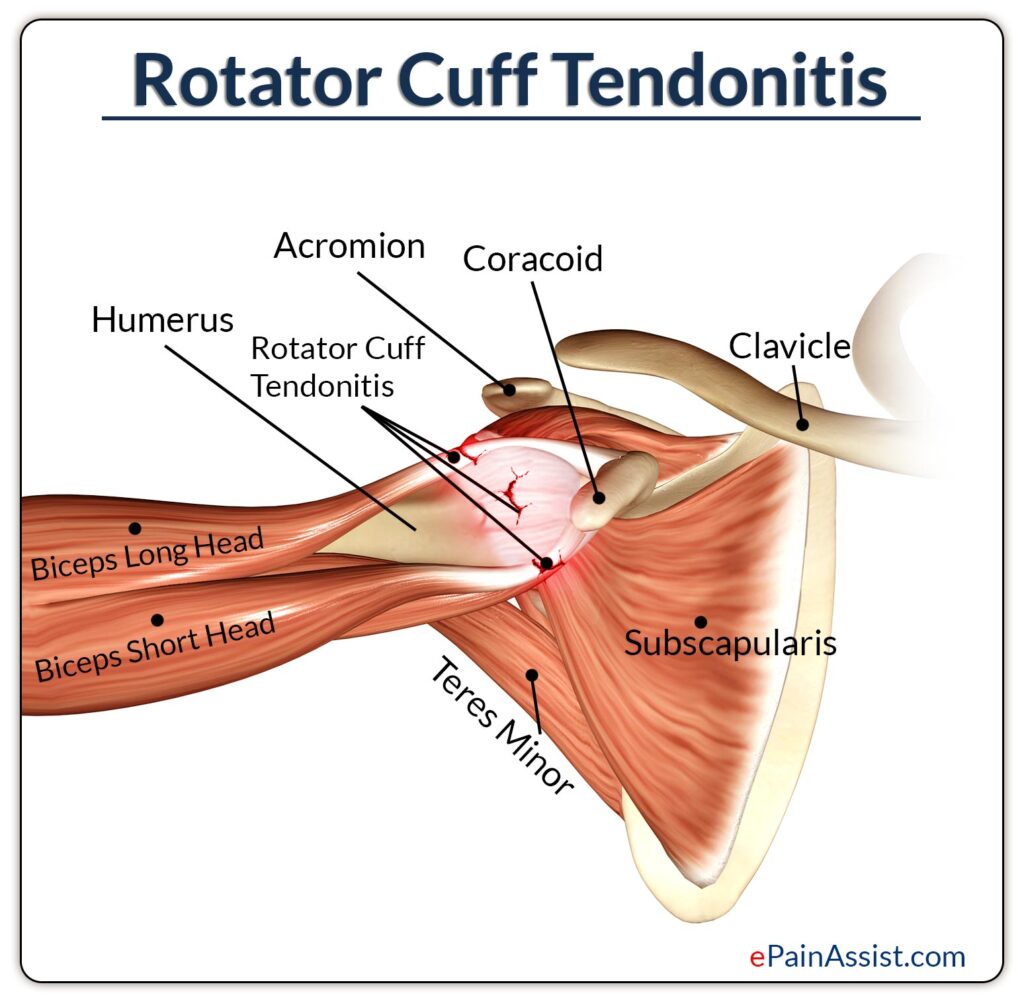
What is rotator cuff tendonitis?
Rotator cuff tendonitis is a condition that leads to inflammation of the tendons in the shoulder. This condition can be extremely painful and make it difficult to move the arm. The rotator cuff is a group of four muscles and tendons that attach the shoulder blade to the upper arm bone. These muscles and tendons help lift the arm.
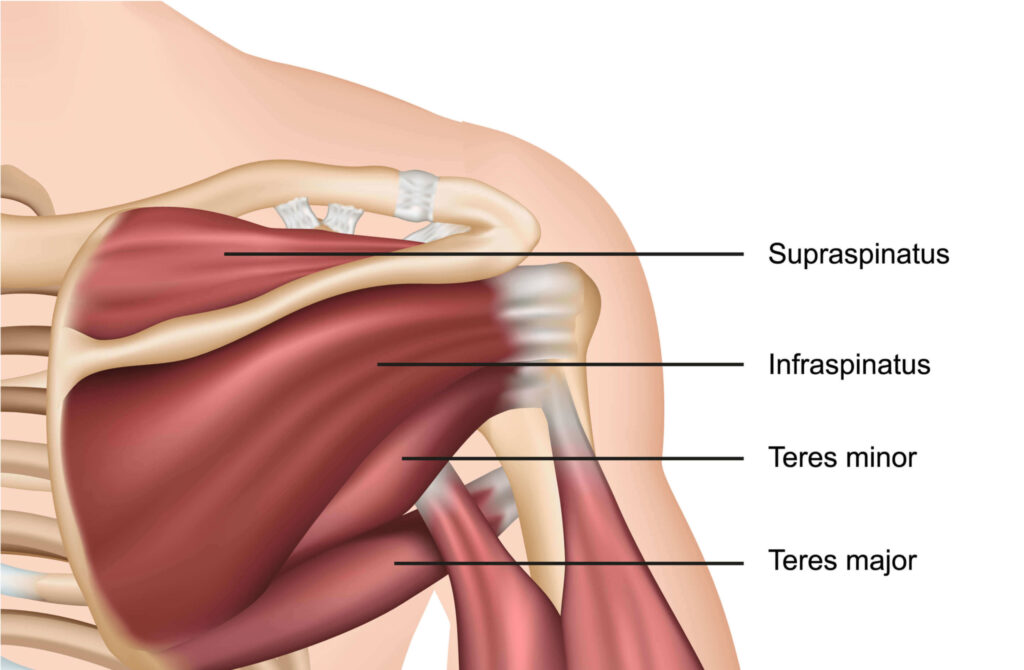
Types of Rotator Cuff Tendonitis
There are four types of rotator cuff tendonitis, which are classified based on the location of the inflammation.
1. Supraspinatus Tendonitis:
This type of rotator cuff tendonitis affects the supraspinatus muscle and tendon, which is located at the top of the shoulder.
2. Infraspinatus Tendonitis:
This type of rotator cuff tendonitis affects the infraspinatus muscle and tendon, which is located at the back of the shoulder.
3. Teres Minor Tendonitis:
This type of rotator cuff tendonitis affects the teres minor muscle and tendon, which is located at the bottom of the shoulder.
4. Subscapularis Tendonitis:
This type of rotator cuff tendonitis affects the subscapularis muscle and tendon, which is located at the front of the shoulder.
Symptoms of rotator cuff tendonitis
Most people with rotator cuff tendonitis have pain and stiffness in the shoulder, especially when they try to lift their arm above their head. The pain may also extend down the arm. Other symptoms include:
-A creaking or grinding sensation when the shoulder is moved
-Weakness in the arm and shoulder
-Difficulty sleeping on the affected side
If the condition is severe, there may be a visible lump on the shoulder. In some cases, the arm may even be partially or completely immobilized.
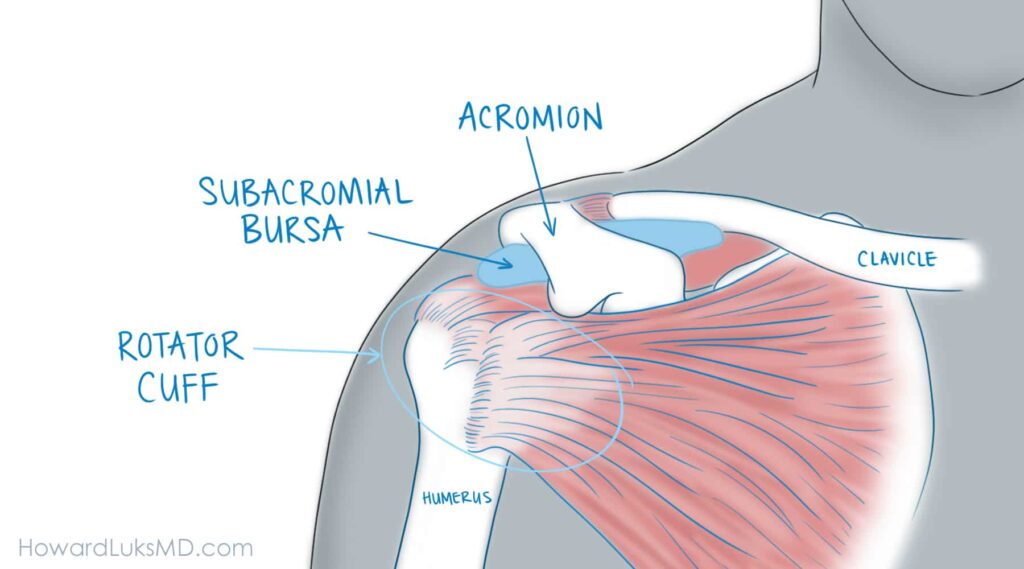
Causes of rotator cuff tendonitis
The exact cause of rotator cuff injury is often unknown. However, it is thought to be caused by a combination of overuse and age-related wear and tear. This condition is more common in people who perform repetitive overhead motions, such as those involved in baseball or tennis. It is also more common in older adults.
Rotator cuff tendonitis can also be caused by an injury, such as a fall or direct blow to the shoulder. This type of injury can damage the tendons and muscles around the shoulder, leading to inflammation and pain.
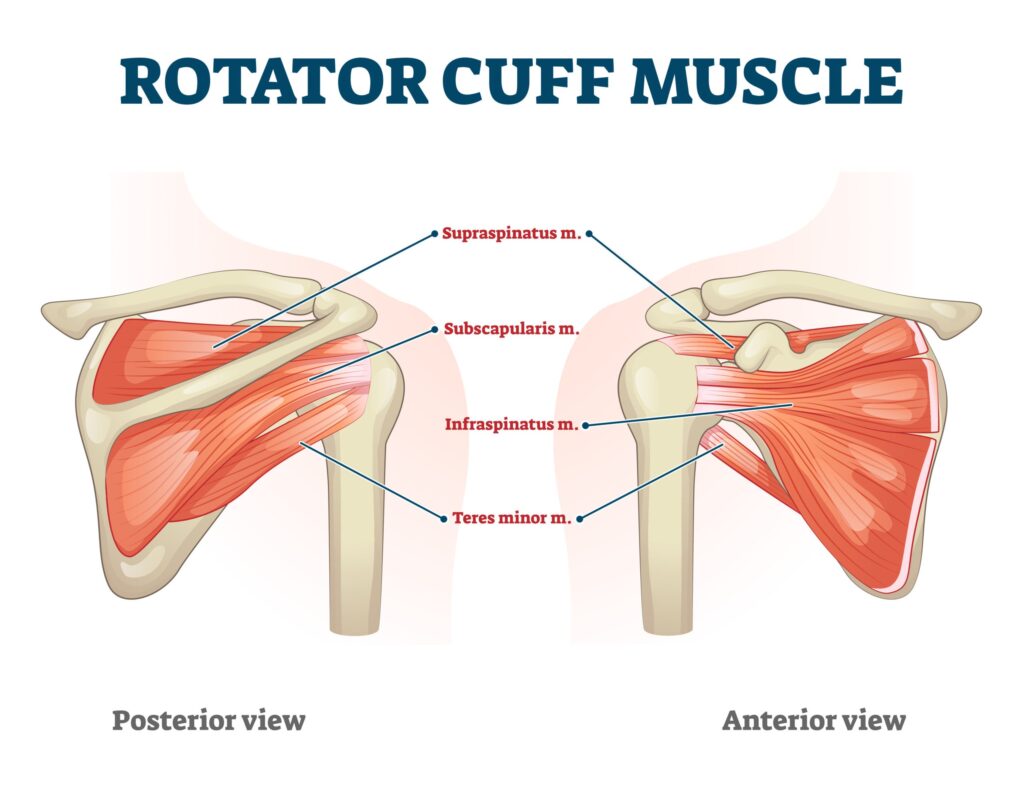
Diagnosis of rotator cuff tendonitis
The diagnosis of rotator cuff tendonitis generally begins with a visit to your doctor. He or she will ask about your symptoms and perform a physical examination. The examination will likely include tests to assess range of motion and strength in your shoulder. X-rays may also be taken to rule out other conditions, such as arthritis or fractures. Rotator cuff pathology can also be seen on MRI.
Physical Examination:
Your doctor will start by asking you questions about your symptoms and medical history. He or she will then perform a physical examination of your shoulder. This will likely include tests to assess range of motion and strength. The examiner may also press on different areas around your shoulder to check for tenderness or pain.
X-rays:
X-rays may be taken of your shoulder to rule out other conditions, such as arthritis or fractures. However, rotator cuff tendonitis does not usually show up on X-rays.
MRI:
An MRI (magnetic resonance imaging) scan may be ordered to further evaluate the condition of your rotator cuff. This test is very good at showing the soft tissues of your shoulder, such as the tendons.
TSE:
A TSE (tendinosis early sign) test may be performed to help diagnose rotator cuff tendonitis. This test involves injecting a contrast dye into the space around your rotator cuff. The dye helps to make the tendons more visible on an X-ray.
Treatment for Rotator Cuff Tendinitis:
There are several treatment options available for rotator cuff tendonitis. Treatment generally focuses on reducing pain and inflammation and restoring normal shoulder function.
Rest
Rest is often recommended as a first line of treatment for rotator cuff tendonitis. This means avoiding activities that aggravate your symptoms. You may need to use a sling or ice pack to help keep your shoulder immobile and reduce pain.
Physical therapy:
Physical therapy can be very helpful in treating rotator cuff tendonitis. A physical therapist can teach you exercises to stretch and strengthen the muscles and tendons around your shoulder. He or she can also give you tips on how to avoid activities that may aggravate your symptoms.
Anti-inflammatory medication:
Anti-inflammatory medication, such as ibuprofen, can be helpful in reducing shoulder pain and inflammation. Be sure to follow the instructions on the label carefully.
Corticosteroid injections:
If other treatments are not effective, corticosteroid injections may be recommended to give relief from rotator cuff pain. These injections can help reduce inflammation and pain in the affected arm. However, they are not usually given more than three times per year.
Surgery:
Surgery is generally only recommended for rotator cuff repair if other treatments have failed to relieve symptoms. Surgery for rotator cuff tendonitis typically involves repairing or removing the damaged tendons.
There are three main types of surgeries performed to treat RC tendonitis:
Arthroscopic debridement:
Arthroscopic debridement is a minimally invasive surgery that involves removing the damaged
tissue around the tendon.
Arthroscopic repair:
Arthroscopic repair surgery involves stitching the tendon back to the bone. This type of surgery is usually only done if the tendon is still partially attached.
Open repair:
Open repair surgery involves making an incision in the skin over the shoulder so that the surgeon can access the tendon. The damaged tissue is then removed and the tendon is repaired or replaced.
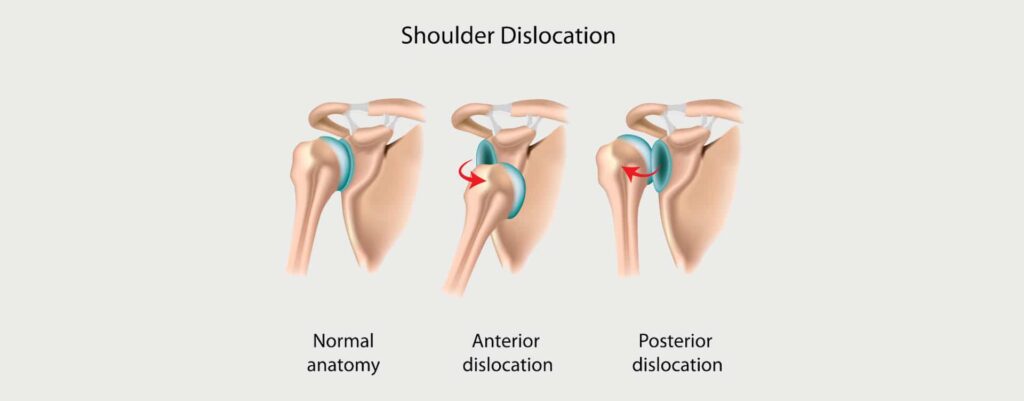
Recovery after a Rotator Cuff Tendonitis Surgery
The recovery from a rotator cuff tendonitis surgery generally takes place in three stages. The first stage, which lasts for two to three weeks, focuses on reducing pain and inflammation. The second stage, lasting four to six weeks, focuses on regaining range of motion and strength. The third stage, lasting eight to twelve weeks, focuses on returning to full function.
The following are some tips for a successful recovery from any rotator cuff disease:
- Rest is essential for healing. It is important to take it easy and not overdo it during the first few weeks after surgery.
- Physical therapy will be important in order to regain range of motion and strength.
- Follow all of your doctor’s orders and attend all scheduled appointments.
- Be patient during the recovery process. It takes time for the incision to heal and for the full range of motion to return.
- Stay positive and remain motivated throughout the recovery process.
Risk Factors of Rotator Cuff Tendonitis
Common risk factors for developing rotator cuff tendonitis include:
– Age: The condition is more common in people over the age of 40.
– Gender: Men are more likely to develop rotator cuff tendonitis than women.
– Obesity: People who are obese or overweight are more likely to develop the condition.
– Smoking: Smoking tobacco can increase the risk of developing rotator cuff tendonitis.
– Repetitive motions: Jobs or activities that involve repetitive motions of the shoulder, such as painting or lifting, can contribute to the development of rotator cuff tendonitis.

Tips to prevent rotator cuff tendonitis
- Avoid repetitive overhead motions of the arm. If you participate in activities that require repeated overhead arm motions, take frequent breaks to rest your shoulder.
- Use good posture and alignment when participating in overhead activities. Be sure to keep your shoulders down and back, and avoid rounding your upper back.
- Use appropriate weightlifting form to avoid rotator cuff problems. When lifting weights overhead, be sure to use a wide grip and keep your elbows close to your body.
- Use appropriate ergonomics when working at a computer or desk. Be sure your chair and desk are at the proper height, and take breaks often to stretch your arms and shoulders.
- Stretch your shoulders and chest regularly. A regular stretching routine will help keep your muscles and rotator cuff tendons flexible, which can prevent rotator cuff tears of all sorts.
- Strengthen your rotator cuff muscles. Strong muscles will better support your shoulder joint and help prevent rotator cuff tear.
- Wear supportive shoes when participating in activities that put stress on your shoulders. Proper footwear can help reduce the impact on your joints and muscles. IN this way, you can avoid rotator cuff injuries from happening.
- Use ice to reduce pain and inflammation. Ice can be applied for 15-20 minutes at a time, several times a day.
- Take anti-inflammatory medication as needed. Nonsteroidal anti-inflammatory drugs (NSAIDs) can help reduce pain and inflammation.
- See a doctor if you experience persistent pain or swelling in your shoulder. A doctor can diagnose the cause of your symptoms and recommend treatment options.
Frequently Asked Questions
Rotator cuff tendinopathy is a condition that affects the tendons in the shoulder. The rotator cuff is a group of four muscles and tendons that attach the shoulder blade to the upper arm bone. The rotator cuff muscles and tendons help lift the arm. The condition is caused by overuse or injury to the rotator cuff tendons. This can occur from repetitive motions, such as those often used in sports, or from a single event, such as a fall.
RC tendinosis is a condition that results from the overuse of the rotator cuff muscles and tendons. These muscles and tendons attach the shoulder blade to the upper arm bone. The rotator cuff muscles and tendons help lift the arm. RC tendinosis is a type of tendonitis, which is an inflammation of the tendons. RC tendinosis is a chronic (long-term) condition that is seen more often in middle-aged and older adults.
There are a number of treatments that can be effective for shoulder tendonitis, depending on the severity of the condition. For milder cases, resting the shoulder and avoiding activities that aggravate the condition can often be enough to allow the inflammation to subside. Applying ice to the affected area may also help to relieve pain and inflammation.
The short answer is that rotator cuff tendonitis can take a long time to heal. The reason for this is that the rotator cuff is a very complex structure, and it is difficult to rest it completely. If you are doing everything right, however, you should start to see some improvement within a few weeks. If you have rotator cuff tendonitis, it is important to see a doctor. The sooner you start treatment, the better your chances are of recovering quickly.
The short answer is no, but the long answer is a little more complicated. Rotator cuff tendonitis is an inflammation of the tendons in the shoulder, and while it can be a chronic condition that comes and goes, it is not a permanent condition. However, if rotator cuff tendonitis is left untreated, it can lead to other problems such as rotator cuff tears, which can be permanent. If you think you may have rotator cuff tendonitis, it is important to see a doctor so that you can get the proper treatment.
3 Ways to Level Up Your Rehab and Injury Prevention With Us




